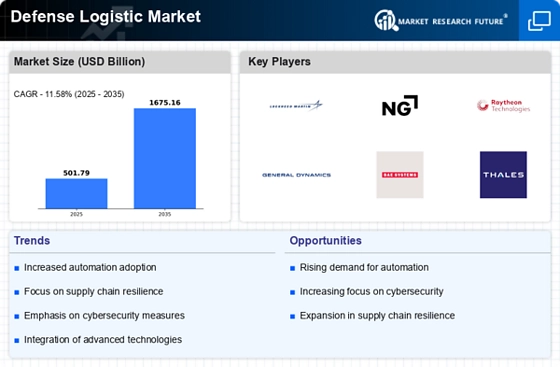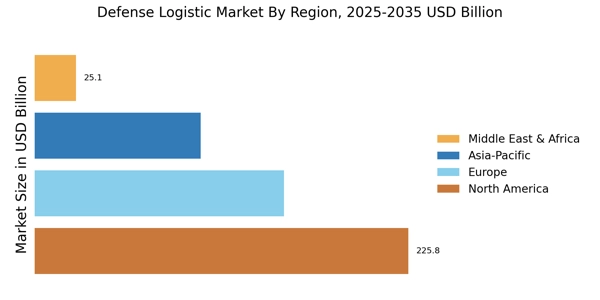Geopolitical Tensions
Geopolitical tensions and conflicts are driving the demand for enhanced logistics capabilities within the Defense Logistic Market. As nations face increasing security challenges, the need for efficient and responsive logistics support becomes paramount. For instance, ongoing tensions in Eastern Europe and the Asia-Pacific region have prompted countries to bolster their military readiness, which in turn necessitates robust logistics frameworks. The market is likely to see a surge in demand for logistics services that can support rapid deployment and sustainment of military forces in these regions. Analysts suggest that this trend may lead to an increase in contracts for logistics providers, thereby expanding the Defense Logistic Market.
Increased Defense Budgets
The rise in defense budgets across various nations appears to be a primary driver for the Defense Logistic Market. Governments are allocating more resources to enhance military capabilities, which necessitates robust logistics support. For instance, the United States has proposed a defense budget exceeding 700 billion dollars for the fiscal year 2025, indicating a strong commitment to military readiness. This trend is mirrored in several countries, where defense spending is projected to grow by an average of 3-5% annually. Such financial commitments are likely to stimulate demand for logistics services, including transportation, supply chain management, and maintenance support, thereby propelling the Defense Logistic Market forward.
Technological Advancements
Technological advancements are reshaping the Defense Logistic Market, as innovations in automation, artificial intelligence, and data analytics enhance operational efficiency. The integration of advanced technologies facilitates real-time tracking of supplies and equipment, which is crucial for military operations. For example, the adoption of AI-driven logistics solutions can optimize supply chain processes, reducing costs and improving response times. Furthermore, the market for military logistics technology is expected to grow significantly, with estimates suggesting a compound annual growth rate of around 6% over the next five years. This technological evolution not only streamlines logistics operations but also ensures that military forces are better equipped to respond to emerging threats.
Focus on Supply Chain Resilience
The emphasis on supply chain resilience is becoming increasingly critical within the Defense Logistic Market. Recent disruptions in global supply chains have highlighted vulnerabilities, prompting defense organizations to reassess their logistics strategies. As a result, there is a growing focus on developing more resilient and flexible supply chains that can withstand unforeseen challenges. This shift is likely to drive investments in logistics infrastructure and technology, as defense entities seek to ensure uninterrupted support for military operations. Reports indicate that investments in supply chain resilience could increase by approximately 10% annually, reflecting the urgent need for robust logistics solutions in the defense sector.
Sustainability and Environmental Considerations
Sustainability initiatives are gaining traction within the Defense Logistic Market, as military organizations increasingly recognize the importance of environmentally responsible practices. The push for greener logistics solutions is driven by both regulatory pressures and a commitment to reducing the environmental impact of military operations. For instance, many defense agencies are exploring alternative fuels and energy-efficient transportation methods to minimize their carbon footprint. This trend is expected to influence procurement strategies, with a growing preference for logistics providers that prioritize sustainability. Analysts predict that the market for sustainable logistics solutions in defense could grow by 8% annually, reflecting a significant shift towards environmentally conscious practices in the industry.


















Leave a Comment